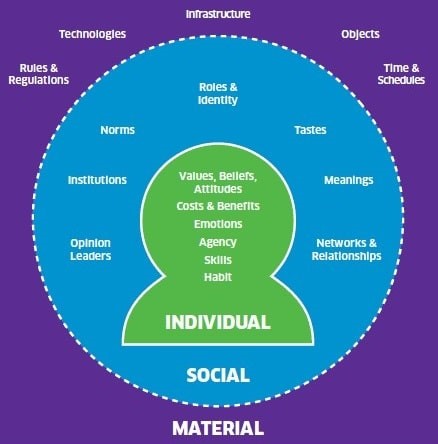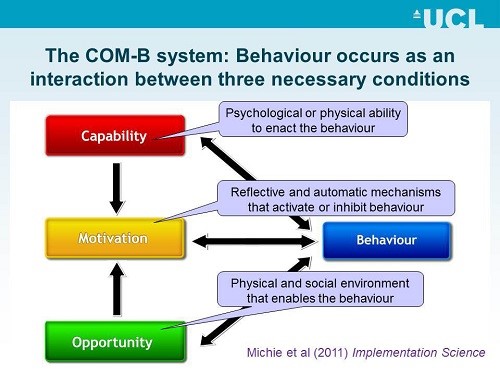National Highways takes a variety of behavioural, social and physical factors into account when seeking to enable, engage and support people to drive safely on England’s motorways and major A-roads.
Features
How do we get people to change behaviours to improve safety on our roads?
At National Highways, the organisation that manages and improves England’s motorways and major A roads, safety is our first imperative and we champion a Safe Systems approach to delivering it. Through this holistic approach we work collaboratively to design and deliver a network that enables and encourages users to make safe, smooth and sustainable journeys.
 Driver behaviour change is a marathon not a sprint. Photograph: iStock
Driver behaviour change is a marathon not a sprint. Photograph: iStock
A golden thread running through the holistic Safe Systems approach is the need to understand people and how to support them to behave safely. We recognise that road users are active participants in the safe system and we need to engage and work with them if we are to continuously improve safety and their make journeys better.
Taking a sociological perspective helps us understand the interaction of many of the ways we can influence behaviour – it puts people at the centre of the model but recognises the influence of physical and social contexts. See Figure 1 below.
 ISM model Darnton
ISM model Darnton
If we apply this to driving safely, we can see that how we use the roads is shaped by:
- Who we are as individuals i.e., our personal characteristics, values, beliefs, needs, experiences, skills and capabilities and motivations. Are we inexperienced in experienced drivers? Are we competent and confident? Do we understand and accept the rules of the road? Etc.
- The social context – i.e., our behaviours are also strongly influenced by the behaviour of others around us and our perceptions and understanding of appropriate behaviour: what is socially, culturally, and legally accepted and expected?
- The physical/material and wider context in which we operate – i.e., geography, roads and vehicles. Roads and vehicles provide many physical cues, giving drivers feedback that guides and informs white lines, in-vehicle alerts, speedometers, bends and inclines, road signs (fixed and variable).
A marathon not a sprint
Behaviour change is a marathon not a sprint. In order to enable people to change their behaviour and for that change to be sustained, we need to understand the behaviour; who is doing it and why; the barriers and motivators to changing it and what are the best approaches to take when to engage and enable, encourage and – if appropriate – enforce change.
Road safety has a long tradition of taking behavioural approaches – for example, on drinking and driving. Over many decades the public were made aware of the risks and consequences of driving drunk. Through early campaigns targeting messages at mainly male drivers, and political will, it became socially unacceptable. Having won the hearts and minds of the public, laws were introduced as was police enforcement.
Alongside improvements in enforcement technologies and targeted enforcement came regular supporting campaigns to raise awareness of the issue and consequences; the rationale for enforcement and the easy actions that could be taken to avoid it – for example, designated drivers, non-alcoholic drinks, planning taxis etc. These have combined to make it a very unacceptable behaviour. More recent activities in this area include targeting employees and alcohol ignition locks and campaigns that focus on the offender or peer-to-peer messaging support.
The drunk driving example above demonstrates that effective and sustained behaviour change requires good evidence of the behaviour and what works to change it. It requires a multi-disciplinary and multi-pronged approaches that build on each other to establish new behaviours and reinforce and maintain them. It starts with awareness raising and positive reinforcement and this continues but at some point, negative reinforcement is required in both messaging and enforcement.

Understanding drivers’ behaviours
To understand drivers’ behaviours and the barriers and motivators to changing them, we often apply the COM-B model – see figure 2 above.
In this we ask if the drivers have the:
- Capability to change – do they have the knowledge, skills and understanding to do the safer behaviour. Do they feel competent and confident to behave safely?
- Opportunity – are they able to change their behaviour – for example, are there in-journey reminders and triggers to support them to make safer choices, such as chevrons to help them keep their distance; and in-vehicle or on-road feedback on their speed? Will they remember not to feel pressure from other drivers?
- Motivation – what’s in it for them? Will they feel they are doing the right thing – for example, when a speed-activated sign gives them a smiley face to indicate they are sticking to the limit? Will they identify themselves as good/considerate drivers? Will they feel that others they respect would like them to behave that way?
Raising awareness
Driving is a complex task that requires high levels of engagement for it to be done safely.
We want drivers to be and feel competent, confident and considerate road users and most are. But we are only human and sometimes our driving behaviours may become reflexive – some habitual behaviours and behaviours where we confirm to what we think others expect of us can result in risky behaviours. These social normative and habitual behaviours can be particularly difficult to shift. But there are many ways to address them.
Raising awareness can be a good starting point – sometimes people are unaware of their behaviour and the impact it has on others. People need a rational to change their behaviour and a clear instruction on what they can do to change their behaviour. But just telling people what to do and why is not enough. We need to address barriers and motivators to them changing their behaviours – for example, designing a physical environment (the road and the vehicle) that provides cues/triggers to support safer driving. We may also for some groups try to make the unsafe behaviour harder or less acceptable to do.
Communication is vital
Communication is vital to enabling and encouraging behaviour change. For instance, we can raise awareness of what to do and why; we can effectively personalise and tailor messages for maximum impact with particular groups/behaviours; we can address knowledge and understanding of skills and consequences; and we can amplify messages and complementary activities and expectations – for example, we can tell people about the penalties they face when they fail to do something safely on the road or the enforcement activity that will follow.
 Deirdre O’Reilly: "We must tell/show people the positive behaviour we’re asking them to do."
Deirdre O’Reilly: "We must tell/show people the positive behaviour we’re asking them to do."
Good communication can help shift and reinforce positive social norms. Our road safety campaigns to discourage tailgating provide an example of the importance of this approach. Tailgating is a risky driver behaviour and a contributory factor in many crashes. It is also reported in driver feedback to make drivers feel unsafe and frustrated. Our population-wide campaign to raise awareness had a ‘Don’t be a space invader’ strapline alongside a simple “stay safe, stay back” instruction.
More than just nudges
Behaviour change is more than small nudges and communications activities. These support the final objectives to enable, encourage and – where appropriate – enforce safer behaviours and ultimately fewer crashes and better journeys.
In the foreword to Using Behaviour Change Techniques: Guidance for the road safety community, a report from the RAC Foundation, RAC Foundation director, Steve Gooding, says: “Running road safety interventions can be an intensive and time-consuming activity, so we all want to be sure they’re going to work. But designing effective interventions that will genuinely impact on behaviour isn’t easy.
“Let’s face it, changing any of our behaviours is a challenge, and changing our behaviour as road users is particularly hard. Most of the training we go through as drivers is understandably focused on the skills needed to control a vehicle, rather than the attitude we bring to the task.”
 Effective and sustained behaviour change requires good evidence of the behaviour and what works to change it. Photograph: iStock
Effective and sustained behaviour change requires good evidence of the behaviour and what works to change it. Photograph: iStock
Taking a systematic approach and testing interventions is essential before implementation. Professor Fiona Fylan has produced an excellent guide for the road safety community on developing road safety education and communications behaviour changes. This is available from the RAC Foundation and sets out a step-by-step approach to follow.
A nudge is changing any aspect of the environment/context in a way that alters people’s behaviour in a predictable way without forbidding any options. These signs reinforce the positive.
Changing behaviour: Some golden rules
- Understand the behaviour – gather insights from a range of robust qualitative and quantitative sources to understand who, what, where, when and why.
- Identify barriers and motivators to changing behaviours. Apply COM-B
- Identify the appropriate levers (carrots and sticks) to encouraging safe behaviours and/or discouraging risky behaviours and use them in a planned programme so that activities amplify each other, and any changes are sustained.
- Find an effective way to engage – different people will have different needs, preferences and perceptions. Communications can support changing behaviours but is typically insufficient on its own. Other activities that support behaviour change should be used appropriately such as physical reminders during the journey in-vehicle or on road.
- Tell/show people what you’re asking of them – dramatising the negative behaviour can be an effective way to create drama and grab people’s attention, but we must tell/show people the positive behaviour we’re asking them to do.
- The risk of using fear or threat – showing something graphic and horrible happening as a result of a poor choice has been proven ineffective for a number of reasons (it puts people off, and they don’t associate themselves with the behaviour, etc).
- Influencing social norms to manage expectations and shift beliefs can be effective. But we need to take care not to normalise poor behaviours – we must be wary that sometimes when we ask someone not to do something they are more likely to think about it and therefore do it (for example, ‘no ball games’, ‘keep off the grass’, ‘don’t activate the alarm’, or ‘don’t think of an elephant’.)
- What’s in it for me? – people are predominantly motivated by personal benefits, so we need to show how they will gain by the behaviour.
- Test what works and what doesn’t in terms of behaviour change – this can include evaluating the impact on observed or self-reported behaviours or willingness/intentions to change; social acceptability; knowledge, skills and understanding.
For more information see: nationalhighways.co.uk
Changing behaviour for those who drive for work
National Highways has launched a resource specifically geared at those who employ drivers to help them with setting habits for safer driving. The resource can be found here.
Deirdre O’Reilly is Head of customer insights and behaviour change at National Highways
FEATURES

Pursuing workplace wellbeing through authentic leadership
By Dr Audrey Fleming, British Safety Council on 26 April 2024
By being open, honest and vulnerable in their interactions at work – and genuinely seeking and valuing the input of employees – leaders can develop a workplace atmosphere where trust and respect flourish, in turn supporting the wellbeing, engagement and performance of their teams.

Out in the field: why lone worker monitoring is key
By Rebecca Pick, Pick Protection on 26 April 2024
People working away from a fixed base out in the field may need to quickly summon assistance in an emergency, but it’s important to choose the right communications and alarm technology for their needs.

Why line managers play a vital role in workplace wellbeing
By Marcus Herbert, British Safety Council on 03 September 2023
The behaviours of line managers can have a positive or negative impact on employee health, wellbeing and engagement, so it’s vital managers get staff feedback on whether their management style is supportive or negative, and have regular check-ins so workers can raise concerns about their wellbeing.



